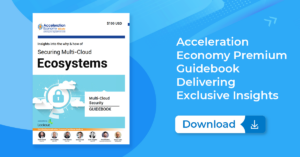In episode 87, an extended edition of the Cloud Wars Horizon Minute, Ronen Schwartz, Senior Vice President and General Manager of Cloud Storage at NetApp, discusses his firm’s 2023 Cloud Complexity Report, released this week, with Cloud Wars Horizon host Tom Smith. The report, with data from 1,300 respondents, goes into depth on how the expanding movement to use multiple cloud providers (multi-cloud) and hybrid raises complexity in areas including cybersecurity, observability, budget management, and more.
This episode is sponsored by Acceleration Economy’s Digital CIO Summit, taking place April 4-6. Register for the free event here. Tune in to the event to hear from CIO practitioners discuss their modernization and growth strategies.
Highlights
01:45 — One source of complexity arises in a hybrid/multi-cloud context because organizations are being requested to support not just the data center, but the cloud — and not just a cloud, but multiple clouds. There is a need to support a data fabric that spans on-premise and multi-cloud, literally with the same resources, without doubling or tripling their resources. One of the things that come up very strongly from the survey, which Schwartz validates from customer engagements, is whether customers need to go to two, three, or even four places to gain visibility and observability.
03:27 — NetApp introduced a platform called BlueXP; it addresses customers’ need to see their entire NetApp data estate in a single place. They also raised the question: can I actually operate it and put policies in place across that estate? Schwartz says these are “relatively early days” for the platforms that provide hybrid and multi-cloud observability and management but “the pain is real, and the need is real.”
04:19 — Cybersecurity is top of mind for those who responded to the survey. Schwartz says he found one surprising point that came out in the survey: different points of view on whether cloud is a solution or whether it’s expanding the problem. Schwartz adds that cybersecurity is not a problem that is limited to one environment vs. another. If the data fabric is becoming hybrid/multi-cloud, it’s difficult to tackle data protection and cyber-resilience in a single place.
05:39 — The survey highlights a huge focus on the ability to show return on investment (ROI) within the short or long term, and organizations are challenged to show that. The economy changed around the same time the survey was conducted, and it’s now still in the same place, so the survey is incredibly relevant. The focus on ROI and total cost of ownership has become key for every organization. Companies are taking action to control their cost and this is translating immediately into showing the ROI that was committed to when the [cloud] project was approved. Another thing that the survey is calling out very clearly is that there is tension between the practitioners, or the lower level, and the more senior levels in the expectations of ROI, and also in the ability to show ROI.
07:37 — The survey addresses expectations from customers’ management environment, in terms of infrastructure manageability and observability, and how much of that they expect to be driven by artificial intelligence (AI). The term continuous optimization comes up in this context, and you may hear “autonomous” optimization. Especially in the cloud, the need to continuously optimize consumption is high, and the best way to do that is to make the infrastructure management environment smarter and smarter. AI can be a mechanism to drive continuous optimization.
For more exclusive coverage of innovative cloud companies, check out Cloud Wars Horizon here:











